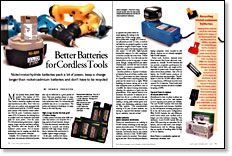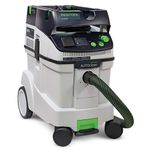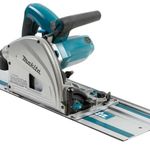Better Batteries for Cordless Tools
Nickel-metal-hydride batteries pack a lot of power, keep a charge longer than nickel-cadmium batteries and don't have to be recycled
Synopsis: The demand for power never seems to end. Here, Dennis Preston defines battery types and what options are available. High energy density is the holy grail of battery design, he says, in that manufacturers are trying to pack a lot of power for a longer time in smaller, lighter packages. Ni-MH batteries power consumer electronics and don’t contain cadmium, mercury, or lead. You won’t have to replace all of your power tools, because new batteries are being packaged to fit in the old battery-pack configurations. Preston also includes information on how to recycle nickel-cadmium batteries.
More power! More power! More power!” The mantra of TV’s Home Improvement tool junkie Tim Taylor is shared by cordless-tool users and manufacturers alike. That’s why you will soon see cordless tools equipped with a nickel-metal-hydride (Ni-MH) battery pack instead of the familiar nickel-cadmium (Ni-Cd) pack. Continuous improvement of Ni-Cd batteries, the driving force in cordless tools, has fueled the inexorable push for more power. Over the years, Ni-Cd batteries have gotten better—higher output, longer run time and faster recharging. However, after two decades as the industry’s prime mover, Ni-Cd battery technology may be topping out while the demand for more power continues.
Initially, Ni-Cd batteries delivered 1.0 amp-hour, the amount of electrical current that can be delivered in a given period of time. They now produce about 2.0 amphours—double those first used in power tools in the early 1980s. Ni-Cd batteries will probably max out at 2.4 amp-hours. The power-tool industry is looking at 3.0 amphours as the next big step.
High energy density: the holy grail of battery design
Cordless power-tool users want drills and saws that deliver a lot of power for a long period of time between charges. To meet this demand, manufacturers continue to research and develop batteries with high energy density, that is, batteries with more power in smaller, lighter-weight packages.
In the past, cordless-tool manufacturers simply raised the voltage to quench the power thirst because upping the voltage is the easiest part of the energy equation to tinker with. A single Ni-Cd battery (or cell) produces only 1.2 volts, so individual batteries are ganged together in series to produce a higher overall output. Six batteries were used in the battery packs of the old, anemic 7.2-volt drills. Eight batteries boosted the output to 9.6 volts, resulting in a tool that actually did some work. Twelve batteries power the 14.4-volt tools. At some point, though, adding batteries just makes a battery pack, and thus the tool, too heavy and bulky, a common complaint with the current, hefty 18-volt drills.
Another problem is disposal of exhausted batteries from all of those cordless tools. The U.S. government has listed cadmium as a hazardous waste requiring proper disposal. While handling the battery during use or at the time of disposal poses no problem, once in a landfill, the battery housing deteriorates, releasing the cadmium to leach into the groundwater. If the expired battery is incinerated, fine particles of cadmium are released into the air or collected in the ash. European and Scandinavian countries are making a strong push toward green technology, and eliminating cadmium is high on their agendas. Tool manufacturers, wanting to be part of these markets, are having to respond with batteries containing no cadmium, mercury or lead.
From Fine Woodworking #134
For the full article, download the PDF below:
Fine Woodworking Recommended Products

Ridgid EB4424 Oscillating Spindle/Belt Sander

Festool Cleantec CT 26 E HEPA Dust Extractor

Makita SP6000J1 Track Saw






















Log in or create an account to post a comment.
Sign up Log in